Ezt szoktam csinálni manapság, ha egy SaaS honlapjáról töltöm le a “natív Maces alkalmazást”.
2020.09.10.
2020.09.09.
Lassú felépülés
A lassan 10 hete tartó bokaszalag szakadás kálváriám kezd megviselni, de azért van fejlődés. A pár héttel ezelőtti gipszlevétel utáni állapothoz képest most már képes vagyok pár lépést megtenni mankó nélkül is.
Az a legnagyobb problémám jelenleg, hogy a jobb lábam még mindig nagyon gyenge. A combom és a vádlim is összeesett az 5 hét fekvéstől és a bicegő séta sajnos nem lesz elég ahhoz, hogy újra megerősödjön. Pénteken újra megyek vissza dokihoz, aki remélem végre elküld valami gyógytornára, ahol mutatnak pár gyakorlatot az izmok erősítéséhez. Úgy érzem ezt most a legfontosabb.
A bokasínt természetesen hordom és naponta gyakorlom a sétát is. Csinálom azt az egy darab nyújtást, amit a doki mutatott.
A duzzanat szerencsére lement részben, a sarkam és bokám mögött az Achilles-ín környékén még mindig püffedt valamennyire. Ugyanígy még akad duzzanat a külső részen is, de szerencsére az elmúlt két-három hétben ez is sokat apadt. 19 napja még a lábujjaim is meg voltak dagadva, azok már legalább normálisan néznek ki.
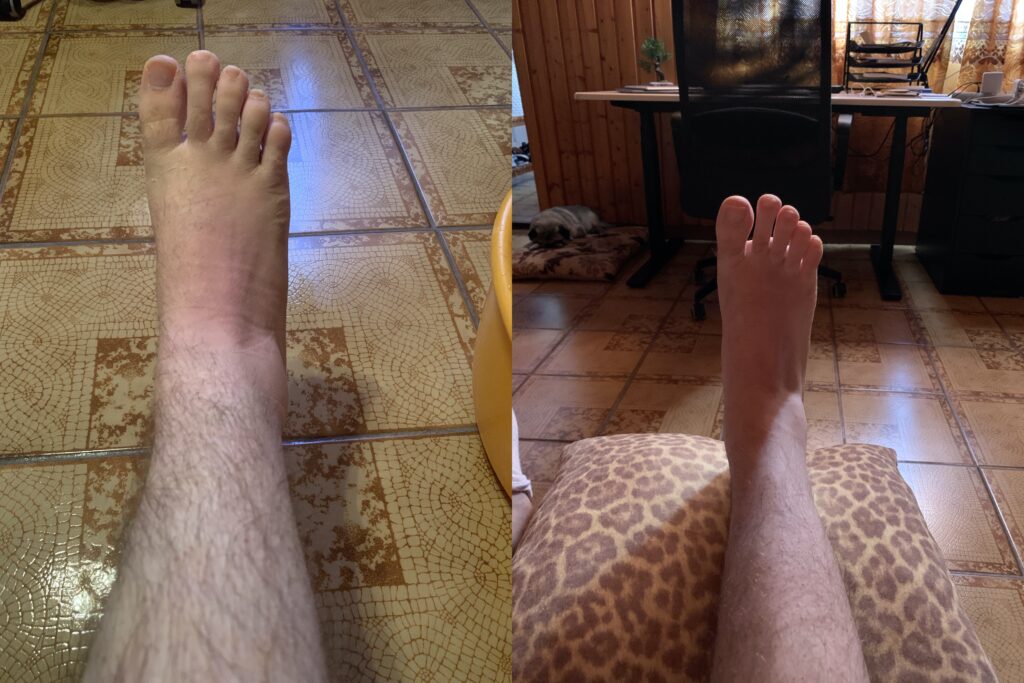
A doki annyit mondott az utolsó kontrollon, hogy legyek türelmes, meg fog gyógyulni a bokám, de ez egy lassú folyamat. Ez talán a legnehezebb az egészben, türelmesnek lenni, de megpróbálok óvatosan mindennap valami apró fejlődést produkálni. Nagyon remélem, hogy a 1-2 hónap múlva már aránylag jól tudok majd sétálni, bokasín és mankó nélkül.
Tanulság: papucsban nem pakolunk semmit!
Készülőben a webfejlesztői leírásaim első része
A múltkor beharangozott webfejlesztői guide-ok első részéhez elkészült a példa repository. Ez egy custom date picker implementációját fogja bemutatni egy Rails alkalmazáson keresztül.
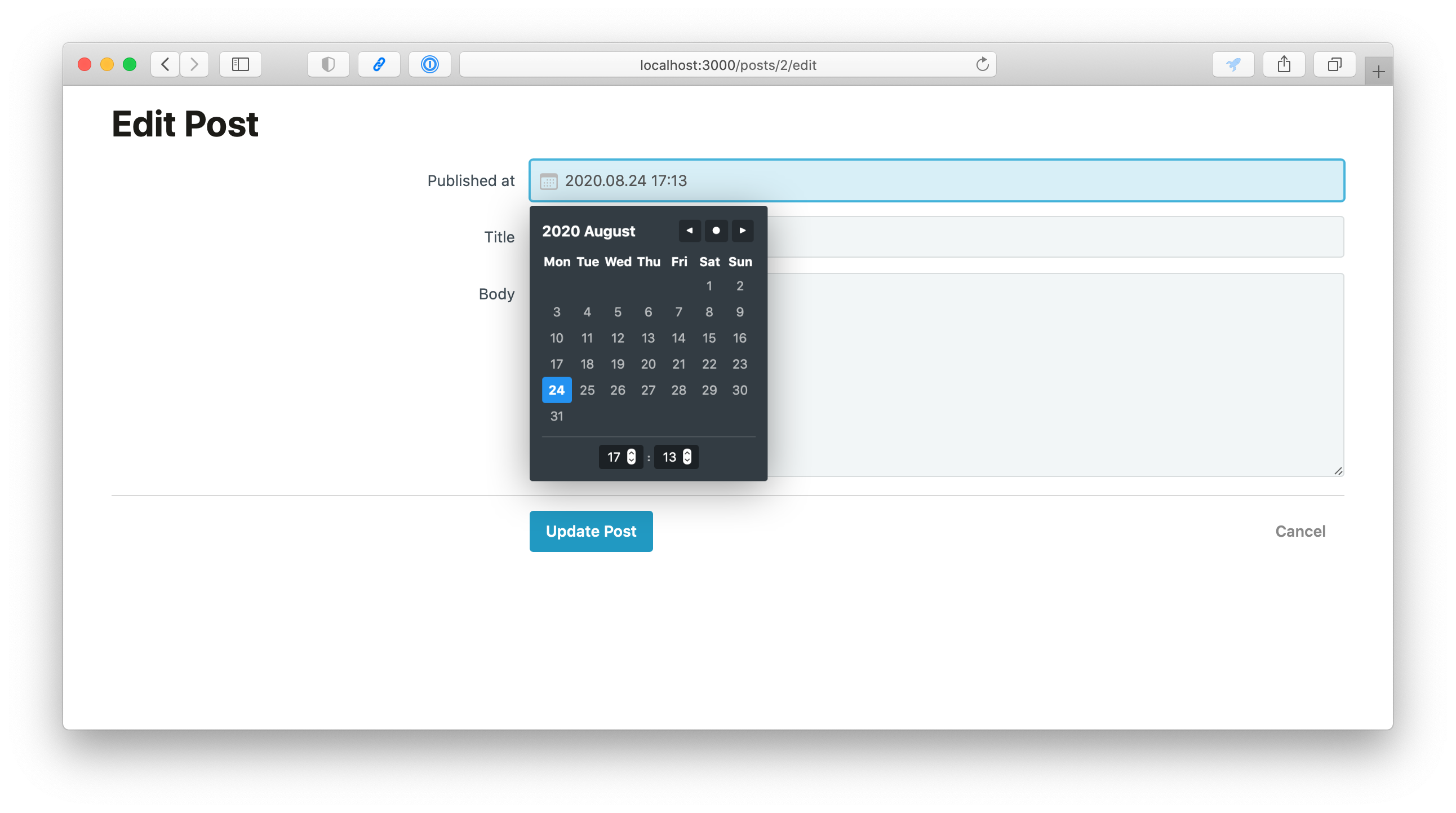
Még össze kell szednem a lényeges részek működésének pontjait, majd jöhet a poszt elkészítése. Annyit már előre jelzek, hogy a leírások angolul lesznek.
2020.09.07.
Big Sir beta 6 UI problémák
Megnéztem újra a Big Sur bétát. Továbbra is azt kell mondanom hogy ez a UI ebben a formában visszalépés.
- Összefolynak az ablakok egymáson (minden fehér).
- Nincs kontraszt, a keresők default kerete olyan halvány szar, hogy alig látszódik a mező a toolbarban.
- Rondák az ikonok, mert szinte mindenhol túltolták a shadowt (mintha valami gagyi Linux distro lenne), kis méretben (16pt) összemosódott színpaca szinte az összes.
- A menüsornak szinte nincs háttere. Lógnak a semmiben az ikonok felül.
- A toolbarban összefolynak a keret nélküli ikonok, néha az aktív ablak is olyan mintha inaktív lenne.
2020.09.01.
A clean start for the web
Egy írás arról, hogy miért egy lassú szemét ma a weblapok nagy része.
When I read blog posts from ‘traditional web developers’ who are mad that HTML & CSS aren’t enough anymore and that everything is complicated – I think this is largely that the application stack for building websites has replaced the document stack in a lot of places. Where we would use Jekyll or server-side rendering, we now use React or Vue.js. There are advantages to that, but for a lot of minimally-interactive websites, it’s throwing away decades worth of knowledge in exchange for certain performance perks that might not even matter.
Azon kellene némelyik JavaScript junkie-nak elgondolkodnia, hogy nem a technológiát választjuk előbb, hanem a célhoz választunk technológiát. A React és a Vue.js nagyszerű cuccok, de az esetek 90%-ban teljesen feleslegesek. Egy fejlesztőnek nem egy technológiába kellene belesűríteni mindent, hanem kiterjedt eszközkészlettel rendelkezve kiválasztani az adott megoldáshoz a megfelelőt, függetlenül attól, hogy trendi vagy nem.
2020.08.31.
Azt hiszem itt az ideje elkezdeni a mászkálást a lakásban fél mankóval. Az előbb elmentem és öntöttem magamnak egy pohár kólát, majd elmostam a poharat. Mindezt egyedül!
2020.08.27.
Az érzés, amikor másfél hónap után egyedül mankóval bicegve, de két lábon (!) elmegyek a hűtőig, kiveszem a kólát, elviszem a konyhába, majd az asztalra rakva kicsúszik a kezemből…
…majd lehajolok érte, várok 10 percet, visszabicegek, kibontom, öntök magamnak egy pohárral és megiszom! ❤️
2020.08.24.
Hamarosan indítani fogok egy új szekciót a blogon web fejlesztési tutorialokra. Az első rész a múltkor megosztott date pickert fogja lebontani és részletezni. További tervek között a tokenes kereső és egy videó chat kliens is.
2020.08.20.
TextSniper
Szuper gyors OCR/screenshot app:
TextSniper is a super useful app to quickly capture unselectable text. Use it to capture and recognize text from presentations, trainings, screencasts,images, pictures, webpages, video tutorials, photos, PDFs etc. Literally from anywhere on your mac’s screen. TextSniper makes it super easy with a single keyboard shortcut convert text from screenshot into editable text. Incredibly fast and useful app.
Én a Prizmót használom erre, de az egy drágább cucc. Akinek gyors és olcsóbb megoldás kell, annak a TextSniper hasznos lesz.
2020.08.14.
Ágyon ülve
Előzmények: Ágyban fekve, Még mindig ágyban fekve és Továbbra is ágyban fekve
Ma járt le az utolsó 2 hét a gipszben, így összesen már 5 hete történt a bokaszalad szakadásom. Voltunk ma kontrolon, megkaptam a bokasínt végre (alatta fásli)! Óvatosan tornáztatnom kell mától a bokámat, ami azt jelenti, hogy előre hátra kell feszíteni, úgy ahogy tudom.
A másik, amitől viszont félek a séta. Meg kellene kezdenem terhelni a lábamat, először két mankóval, majd ahogy haladok a megadott 2. hét végére már csak egy mankóval. Nem gondoltam volna hogy ez lesz, de félek. Nem bízok a lábamban, mindenféle hülye gondolat jár az agyamban, hogy rosszul lépek, akkor megint elszakad, plusz be vagyok szarva a fájdalomtól is.
Az utolsó egy hét elég fos volt. Már napok óta zsibbad a talpam, ráadásul a bokám környékén lévő összes idegszál működésbe lépett, éppen mikor melyikbe nyilal bele. Egyelőre szarul viselem, bár azt hozzá kell tenni, hogy elég szar a fájdalomküszöböm. A szarakodás ellenére megpróbálom tartani a tornát és a mozgást. Ha az elkövetkező 2 héttel megvagyok, akkor elvileg indul majd a gyógytorna.
2020.08.08.
Felmész manapaság egy honlapra:
Fogadd el a cookie-kat! Akarsz-e tőlünk értesítéseket? Be van kapcsolva a reklámblokkolód! Fel akarsz-e iratkozni a hírlevelünkre? Lájkoltad már a Facebook oldalunkat? Ebben a hónapban még 3 cikket olvashatsz, fizess elő itt!
2020.08.05.
Pár hét bokaszalag szakadásos gipszben fetrengés után a mai első fizikai sikerélményem, hogy ide tudtam magamnak hozni egy Túró Rudit a hűtőből.

2020.08.04.
Ha az AgileBits minden platformra meg tudja csinálni rendesen a natív 1Passwordöt (még Linuxra is), akkor semmi kifogása nincs a többi 10x akkora cégnek arra, hogy Electronos szutykokat toljon az arcunkba.
Elég szomorú, hogy sok magyar blogger, akiket 2005–2010 környékén olvasgattam teljesen eltűntek, vagy csak szimpla Twitter retweetgépekké redukálódtak.
Válasz erre: :
Az előző login UX poszthoz még ezt a cikket tudom linkelni, mint kiegészítés.
Mondja már el valaki nekem egyszerű halandónak, hogy miért jó az login közben, hogy először elkéri az oldal e-mail címem, majd gombot nyomok és aztán új oldalon a jelszavamat?
Az utóbbi évek legnagyobb UX-es faszsága.
2020.08.03.
If job interviews for taxi drivers were like for software engineers…
Nagyon ismerős jelenség.
/via @ern0plus4
2020.07.30.
Továbbra is ágyban fekve
Előzmények: Ágyban fekve és Még mindig ágyban fekve
Ma voltunk újabb kontrollon a dokinál.
3 hete fekszek, a lábam felpolcolva. Szerencsére javul a dolog, de még mindig annyira fel dagadva a lábam, hogy nem raktak rá se járógipszet, se bokasínt.
Csináltak egy ultrahangot is ma a bokámról. Teljes ínszalagszakadás, eddig azt hittük csak részleges. Visszatették a pihenős gipszet, majd 2 hét múlva kontrollra vissza kell mennem. A doki szerint nem kell beszarnom, meg fog gyógyulni csak lassabban, mint gondolták. Reménykedek is benne, mert azzal már riogattak páran, hogy a teljes szakadást műteni szokták – igaz Dr. Google mást ír erről – viszont ennyi hét fekvés után egy műtéthez abszolút semmi kedvem (nem mintha egyébként lenne).
Dolgozni szerencsére tudok, igaz takaréklángon, mivel a laptop az ölemben van és a gépelés nehézkes — a cégnél szerencsére mindenki megértő. Legalább valamivel lefoglalom magamat. Egyedül a hátam és a nyakam kezdi feladni, úgyhogy több szünetet kell tartanom. Fürdeni még mindig nem tudok egyedül, Rami segít benne, aki azóta a személyes hősöm lett. Nagyon hálás vagyok neki, mert nélküle nem tudom mi lenne.
Egyelőre ennyi, 2 hét múlva újra jelentkezek…
Az idei Mac Catalyst
A MacStories összeszedte azokat információkat amiket a Mac Catalyst 2.0-ról tudunk:
WWDC 2020 was different. Apple introduced what was effectively Mac Catalyst 2.0 with its Optimized for Mac initiative, a separate Mac Catalyst path that follows Mac conventions more closely but requires more work. The company also built Messages and Maps, two of its flagship apps, using Mac Catalyst, demonstrating a deeper commitment to the technology than ever before. The result is a brighter future for Mac Catalyst that clearly has a role to play alongside SwiftUI and Apple’s other frameworks.
A lényeg nagyjából az, hogy idén kapott egy új opciót minden iPad alkalmazás arra, hogy tényleges natív macOS UI-t használjon a 77%-os skálázás nélkül. Így a Maps és a Messages, mint két nagy rendszeralkalmazás, tökéletes példája lesz az új Catalyst API-k tudásának.
Sajnos a Mapsből eltűnt közben a letéphető popover funkció, a Messagesből pedig az AppleScript támogatás, ami az előző AppKit alapú, iChatből lefaragott kliens még tartalmazott. Nem tudom mennyire van ilyen funkciókra manapság igény, viszont visszanézve azt a rendszerintegrációt, amit annakidején az iChat tudott, sajnos a Messages közelében sincs jelenleg ennek – igaz az app is kevesebbet tud.
Nem szeretném, ha az új többplatformos, natív alkalmazásokból eltűnnének azok a Mac-only apróságok, amik 2006 végén az Apple platformokra csábítottak.
Visszatettem tegnap este az iOS 13-at. Pár nap használat után azt mondom, hogy meglepően stabil, különösebb problémám nem volt vele. Remélem ez őszig így is marad és elkerüljük a tavalyi problémás release-eket.
Egyelőre viszont nagyon hiányzik, hogy a 3rd party appok még nem támogatják az új rendszerfunkciókat.
A Reminders használatára tett kísérletem úgy omlott össze használat közben, mint a kártyavár, úgyhogy visszanyargaltam OmniFocusra 2 nap után. Nem hiába érzem a használata közben, hogy nekem ez a trusted system, mindenesetre nagyon várom már az OmniFocus widgeteket.
2020.07.29.
Egy valamit nem értek. Mi az isten csíkos f*$záért kellett kiszedni az iOS 14-ből a 3D Touchot és lecserélni Haptic Touchra, ha tudja a hardver? Nagyon nem ugyanaz a kettő és hiányzik a 3D Touch.
Google Site Search Service
Már régóta idegesített, hogy az iOS-en oly sokat használt Site Search shortcutomnak nincs macOS megfelelője, úgyhogy ma reggel összeraktam Automatorben. Mindössze annyit csinál a cucc, hogy adott weblapon elindítva megkérdezi mire szeretnék rákeresni, majd megnyitja a Google találatokat egy új Safari tabon az adott oldalról.
2020.07.27.
Reminders widgetek iOS 14 alatt
Az iOS 14 alatt újra megpróbálom használni a Reminderst az OmniFocus helyett. Egész pofás kis UI-t adtak az emlékeztetők szerkesztésére, az ikonok nagyon jól kiemelik a különböző szekciókat.
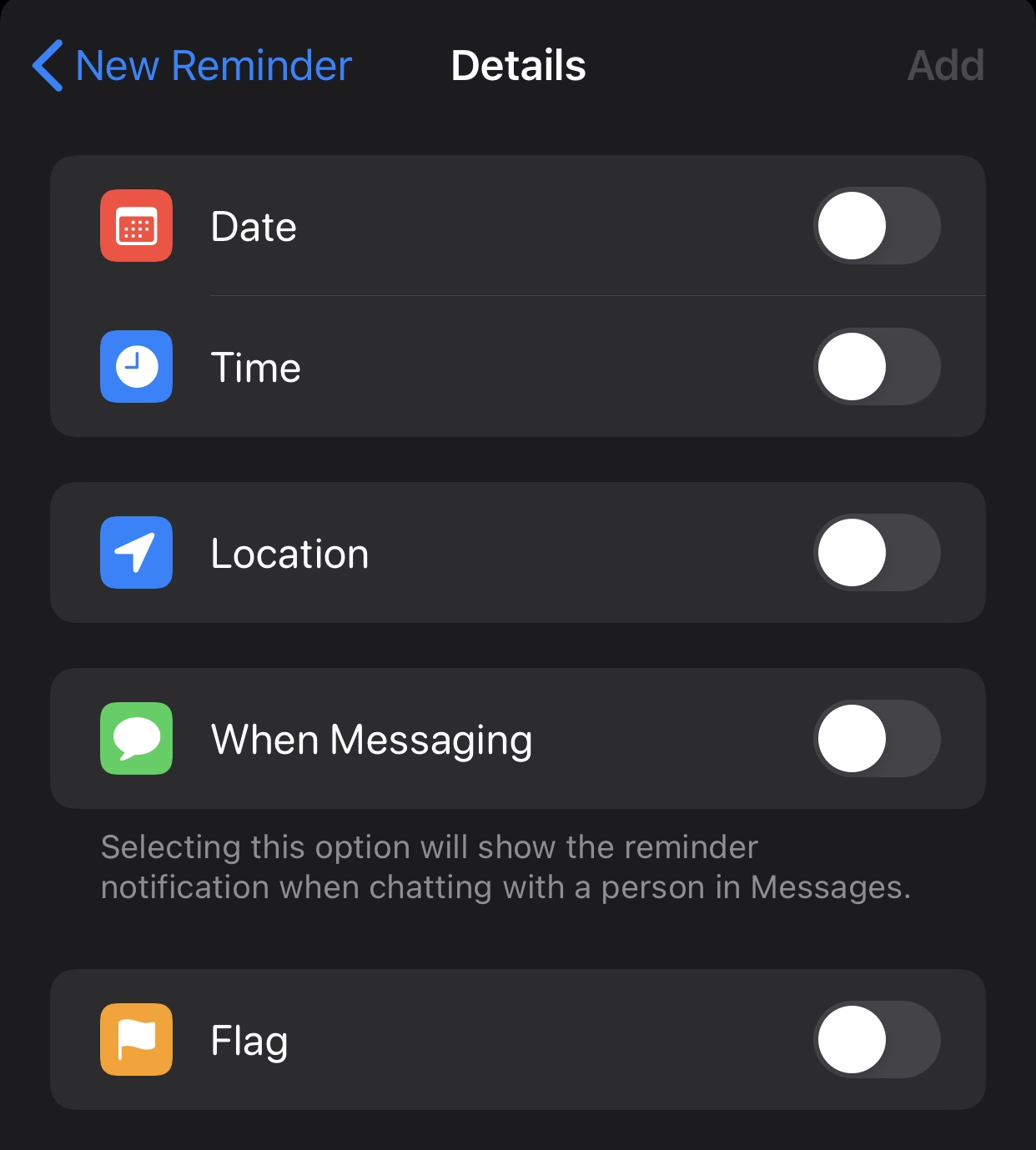
Ami viszont nagyon szexi lehet a GTD-vel integrált Reminders workflowban, az a lista widget, amivel lényegében kipakolhatom az összes következő lépések listámat közvetlenül a home screenre.
Az egyik, amivel mindig problémám van, a telefonhívások, üzenetküldések és e-mailek lista, amit hozzáadtam az első oldal tetején levő Smart Stack widgethez. Így azonnal látom miket kell(ene) a telefonomon csinálnom az adott pillanatban.
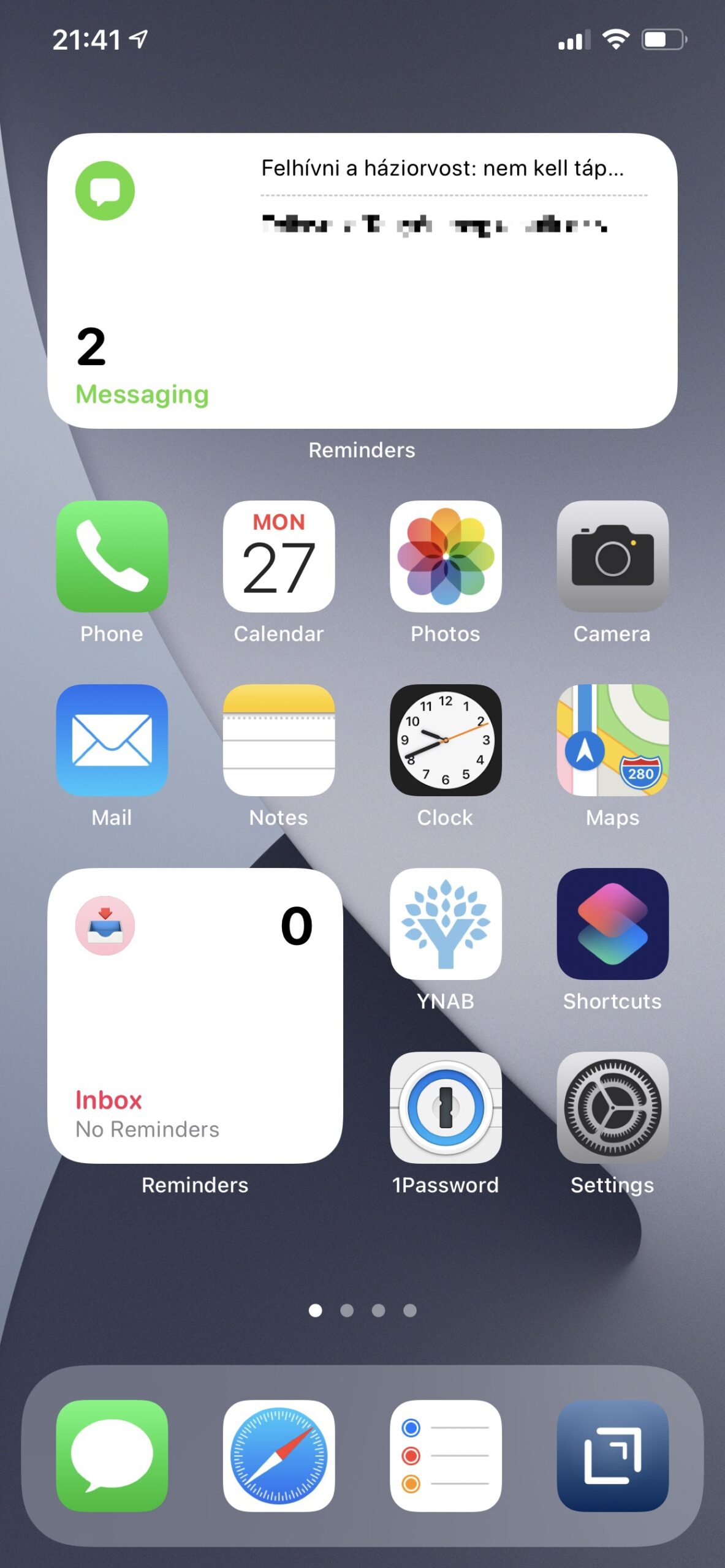
A másik egy dedikált home screen a következő lépésekre. A Reminders lista widgetje kis méretben csak az első tennivalót mutatja a különböző kontextus listámról, így azonnal kapok egy átfogó képet arról, hogy melyik kontextusban mit tudok csinálni.

2020.07.25.
Nem fogom feltenni az iOS 14 bétát. Nem fogom feltenni az iOS 14 bétát. Nem fogom feltenni az iOS 14 bétát. Aztán végülis feltettem az iOS 14 bétát, ami meglepően stabil idén. Viszont azt nem értem, hogy az iPadOS miért nem kapta meg az App Library és Home Screen widgetek funkciókat.
2020.07.21.
Nem hallgattam még meg a Tankcsapda új számát. Nem azért mert nem volt rá időm, hanem mert I don’t give a fuck.
2020.07.14.
Még mindig ágyban fekve
Előzmények: Ágyban fekve
Nos, elvileg csütörtökön leszedik a lábamról a gipszet, amit már alig várok. Nagyon szar a gipsz. Kemény, fáj benne a lábam, aludni sem lehet tőle rendesen, ráadásul amikor mankóval jár az ember, akkor piszok nagy plusz súlyt jelent a fájó bokának.
Tegnap egyébként már egész jól voltam, viszont ma reggel megint úgy keltem, hogy úgy fáj, mint 2 nappal ezelőtt. Lassan a végére érek az első levél fájdalomcsillapítónak. Az éjszaka valahogy rosszul tarthattam a lábamat, mert reggel olyan volt, mintha az összes irányból fájna minden ínszalag. Napközben egy picit enyhült, de elég szar ahhoz képest, hogy tegnap már egész tűrhető volt.
A fürdés hihetetlen szívás. Mivel a gipszet víz nem érheti, így most egy kukászsákot szoktam kötni arra a lábamra, amíg “zuhanyzok”. A részletekbe nem mennék bele, de ha véletlenül ilyen helyzetbe kerülsz, akkor egy szék hasznos lehet a fürdőszobában. A mankóval pedig nagyon óvatosan, piszkosul csúszik a vizes padlón.
Az egész napos fekvés nagyon megviseli a hátamat is. Most már az 5. napot kezdem meg a kanapén hanyatt fekve, a lábamat felpolcova. Néha megemelem és megmozgatom, de egyelőre komolyabb tornát nem tudok csinálni, pedig a neten olvasottak alapján fontos lesz.
Összefoglalva továbbra is szívok, úgyhogy remélem a gipsz levétel és bokasín felrakása után már rohamosabban javulni fogok.
2020.07.11.
Ágyban fekve
Tegnapelőtt pakolás közben megcsúsztam a lépcsőn és ráestem a jobb bokámra. A sürgősségin megnézték, csináltak röntgent, a doki szerint részleges ínszalag szakadás. Kaptam rá gipszet, mellé mankót és egy hét múlva kell jelentkeznem gipszlevételre, ahol majd átrakják bokasínbe.
Jelenleg annyi dolgom van, hogy egész nap fekszek és pihentetem a bokámat. Ez persze nem olyan egyszerű, tekintve hogy 2 napja nem nagyon mozogtam, kezd fájni a derekam és még a lábam is meg van duzzadva. Próbálok olvasgatni a neten, elővettem régi blogokat amiket újraolvastam, de sok hasznos dolgot eddig nem sikerült kihozni a fekvésből. Jelenleg egy projektem van, hogy gyógyuljak. Szerencsére a feleségem segít mindenben – el nem tudja képzelni milyen hálás vagyok neki, főleg tudva, hogy az egész szarság a költözésünk közepén történt.
A zuhanyzás és az éjszakai WC-re járás hatalmas szívás. Ez utóbbira lehet bevezetem majd a férfiak által használható PET palack pisitartályt. Nem túl gusztusos, de még mindig jobb mint mankóval átkelni a lakásban a WC-ig.
A gyógyulási idő elvileg 6–8 hét, bár már annak is örülnék ha a gipszet bokasínre cserélhetném. Kényelmetlen, nehéz, ráadásul rá se lehet állni – nem mintha amúgy rá tudnék állni arra a lábamra – és még víz se érheti. A lényeg hogy ilyenkor újraértékeli az ember az olyan hétköznapi dolgokat, mint a járás és az alapdolgok segítség nélküli elvégzése.
Egyelőre ennyi, pár nap múlva írok, hogy mi történt.
2020.07.08.
Megint előkerült az “Apple touch screen Maceken” dolgozik mém, mivel a Big Surben néhol nagyobb a padding a gombok körül. Ilyenkor csak eszembe jut, hogy biztos akarunk mi touch screen Maceket? Lásd az alábbi iPades illusztrációt…
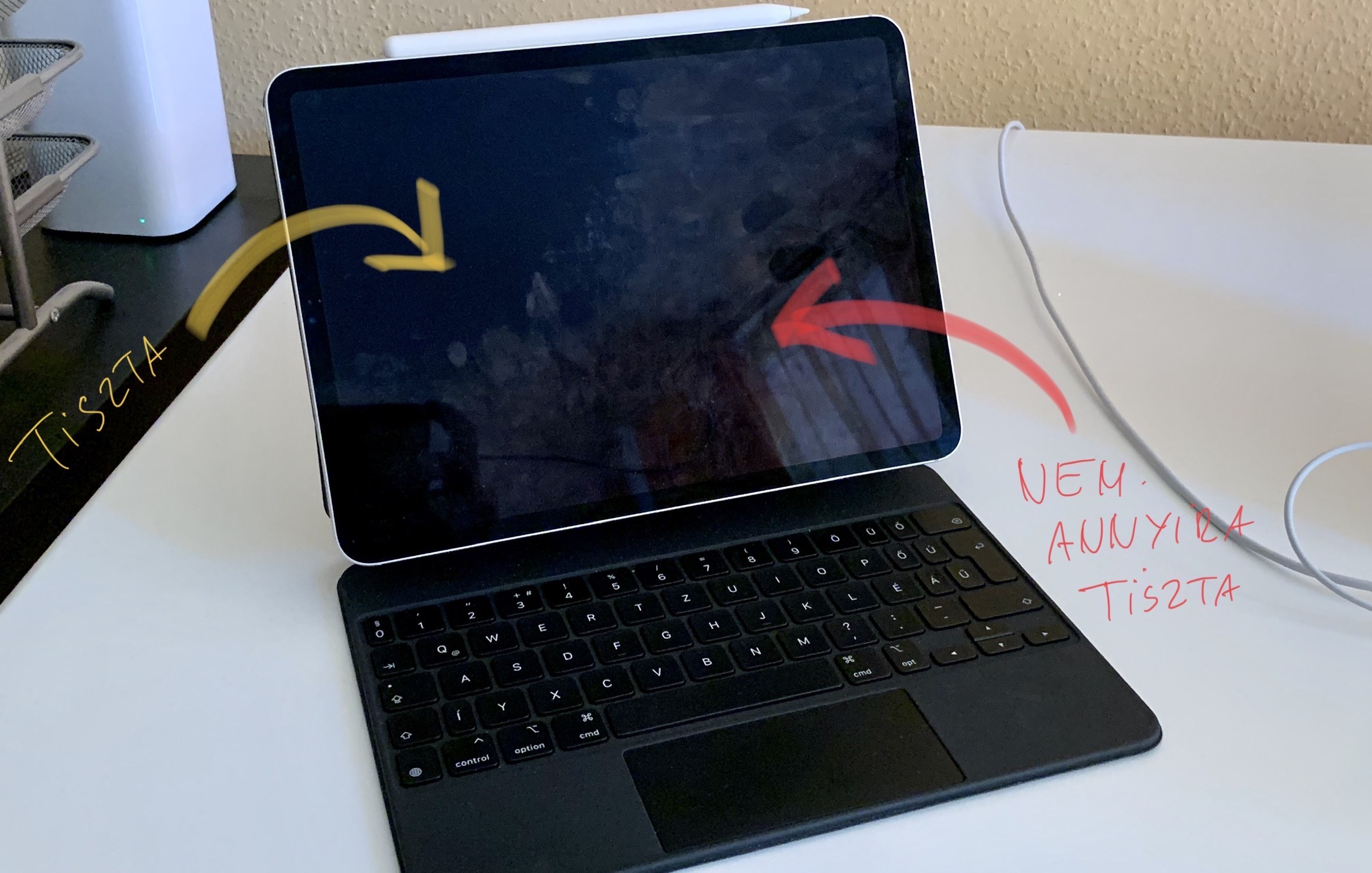
2020.07.04.
Az RSS olvasóm csendben teszi a dolgát
Annak idején nagyon népszerű tartalomfogyasztási forma volt az RSS. Manapság mindenhonnan azt hallom, hogy az RSS egy halott technológia – ami persze baromság – mindenki a social médiát használja. Én is régóta jelen vagyok Twitteren, de az elmúlt 10 év tapasztalata alapján nálam sosem fogja leváltani a social média a feed olvasómat. Sőt, valószínűleg hamarabb fog elhalni nálam a Twitter, mint az RSS.
- Nincs benne algoritmus, minden időrendi sorrendben történik. Ráadásul még át is állíthatom azt.
- Még mindig sokan blogolnak és ennek a legjobb fogyasztási módja az RSS olvasó. Ez az egyetlen olyan szöveges online felület, amiben mai napig el lehet veszni. A legjobb még mindig az, amikor elmélyül az ember egy random cikkben.
- Az RSS egy passzív médiafogyasztási forma. Nincsnek benne reply-k, értesítések és olcsó egó boosterek. Posztok vannak csak, amiket olvasni lehet.
- Nem fog megsértődni senki, ha leiratkozom róluk.
- Nem akarja egy cég az egész internetet a kezében tartani, mindenkit egyenlően kezel az RSS olvasóm.
2020.06.26.
Elképesztő, hogy ezzel az “attention to detail” tudással hogyan sikerült megrajzolni azt a kotonalakú akkumulátor ikont macOS-en.